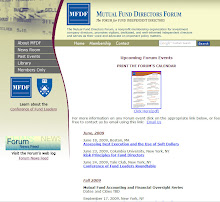An article by Gibson Dunn's Mark Schonfeld, former SEC Director of the New York region, examines a novel First Circuit decision (December 2, 2008) holding that a fund's distributor could be held to violate the Securities Act (Section 10(b) and Rule 10b-5) for material misstatements "impliedly" made by them.
The decision (SEC v. Tambone, ___ F.3d ___ (1st Cir. 2008), 2008 U.S. App. LEXIS 24457), is one of a series of market timing cases brought by the SEC. The defendants in the case were executives at the fund's principal underwriter and distributor, responsible for selling the fund and disseminating the fund's prospectuses and other materials to investors and potential investors, as well as answering their questions. The fund's advisor, with the assistance of the distributor, had included language limiting or prohibiting market timing by the fund's investors. The SEC alleged that, despite these limitations on market timing in the funds' prospectuses, the distributor approved or allowed certain investors to market time the fund in violation of the prospectus language.
At the district court level, the court held that the false or misleading statements about market timing could not be attributed to the distributor because they did not draft the prospectus, and the distributor was not under any obligation to clarify the prospectus language. On appeal, the First Circuit court disagreed. As Schonfeld puts it:
Judge Selya dissented vigorously, calling the novel opinion "judicial adventurism," and noting that it enlarges the scope of primary liability and blurs the line between primary and secondary liability that the Supreme Court recently drew in Stoneridge.
The implications of this somewhat controversial First Circuit opinion on the scope of liability of
defendants in both SEC enforcement actions and securities
litigation may be quite significant.
Mark Schonfeld's article, “A Wider Scope of Primary Liability?,” is available at: http://www.gibsondunn.com/publications/Documents/Schonfeld-StClair-WiderScopeOfPrimaryLiability.pdf
The full text of the First Circuit's Tambone decision is available at: http://www.plol.org/Pages/Secure/Document.aspx?d=7Fiva1fuLuZBc%2f8IySWGeg%3d%3d&l=Cases (free registration required)
The decision (SEC v. Tambone, ___ F.3d ___ (1st Cir. 2008), 2008 U.S. App. LEXIS 24457), is one of a series of market timing cases brought by the SEC. The defendants in the case were executives at the fund's principal underwriter and distributor, responsible for selling the fund and disseminating the fund's prospectuses and other materials to investors and potential investors, as well as answering their questions. The fund's advisor, with the assistance of the distributor, had included language limiting or prohibiting market timing by the fund's investors. The SEC alleged that, despite these limitations on market timing in the funds' prospectuses, the distributor approved or allowed certain investors to market time the fund in violation of the prospectus language.
At the district court level, the court held that the false or misleading statements about market timing could not be attributed to the distributor because they did not draft the prospectus, and the distributor was not under any obligation to clarify the prospectus language. On appeal, the First Circuit court disagreed. As Schonfeld puts it:
With respect to Section 17(a)(2), the Court concluded that, by distributing the misleading prospectuses to investors who then invested in the Columbia funds, the defendants “obtained money or property” by means of an untrue statement of material fact in violation of the statute. For purposes of primary liability under Section 17(a)(2), the Court held “it is irrelevant whether the seller uses his own false statement or one made by another individual. Liability attaches so long as the statement is used "to obtain money or property,‟ regardless of its source.” (Emphasis in original.)For purposes of Section 10(b) and Rule 10b-5(b), which prohibit sellers from mak[ing] any untrue statement of material fact” in connection with the purchase or sale of securities," the First Circuit chose a more novel analysis. The Court reasoned that the defendants “made implied statements of their own regarding the accuracy and completeness of those prospectuses,” and because they have statutory duties and a central role in the securities market, the defendants made "an implied statement without actually uttering the words in question."
Judge Selya dissented vigorously, calling the novel opinion "judicial adventurism," and noting that it enlarges the scope of primary liability and blurs the line between primary and secondary liability that the Supreme Court recently drew in Stoneridge.
The implications of this somewhat controversial First Circuit opinion on the scope of liability of
defendants in both SEC enforcement actions and securities
litigation may be quite significant.
Mark Schonfeld's article, “A Wider Scope of Primary Liability?,” is available at: http://www.gibsondunn.com/publications/Documents/Schonfeld-StClair-WiderScopeOfPrimaryLiability.pdf
The full text of the First Circuit's Tambone decision is available at: http://www.plol.org/Pages/Secure/Document.aspx?d=7Fiva1fuLuZBc%2f8IySWGeg%3d%3d&l=Cases (free registration required)





